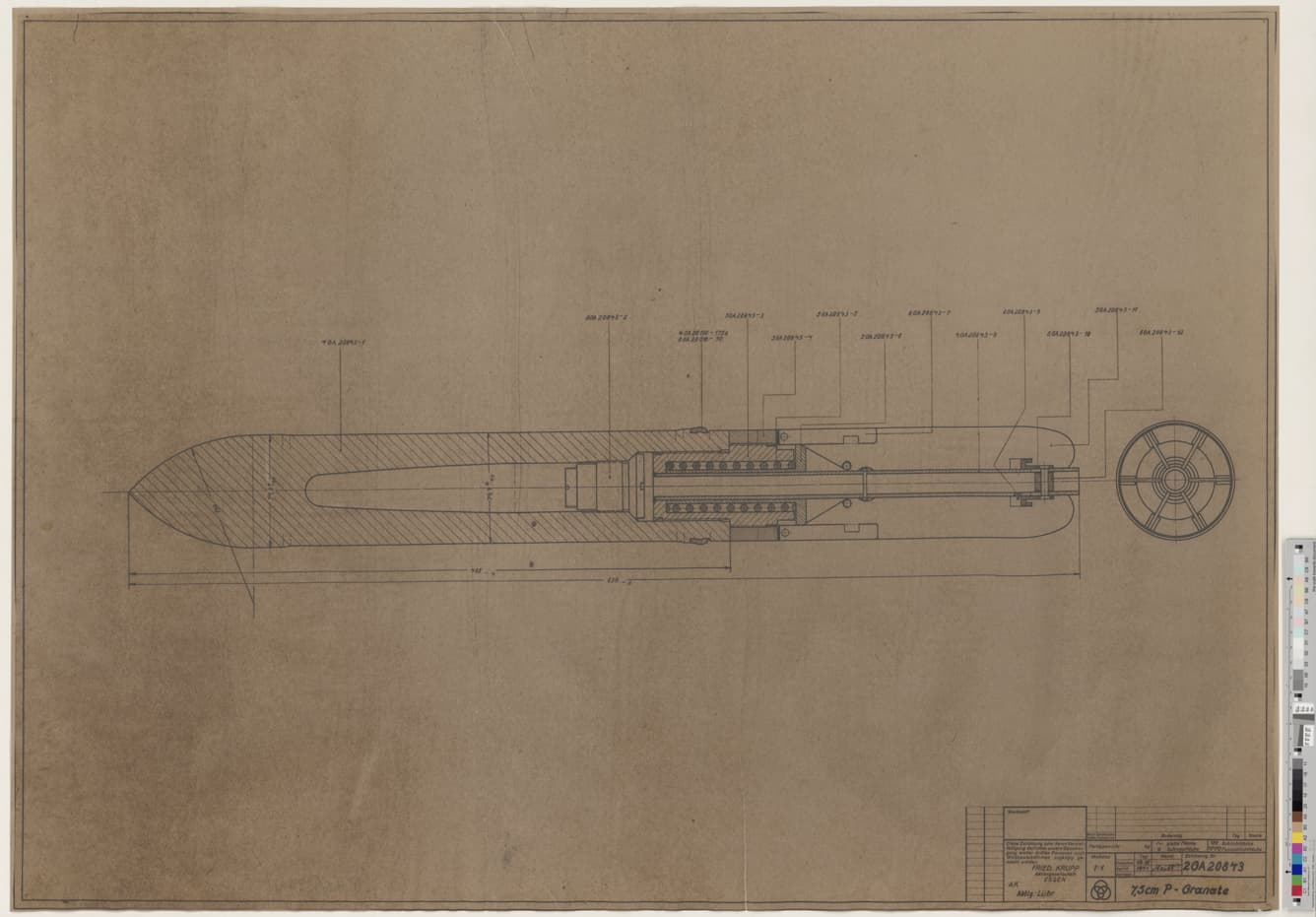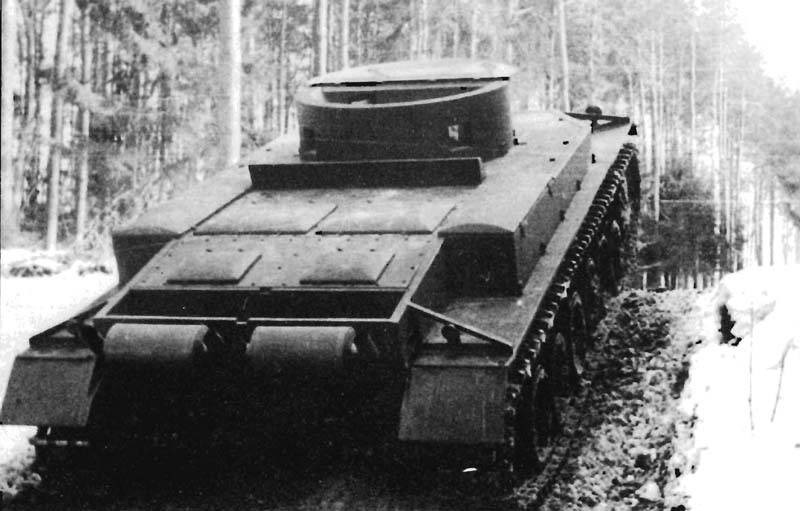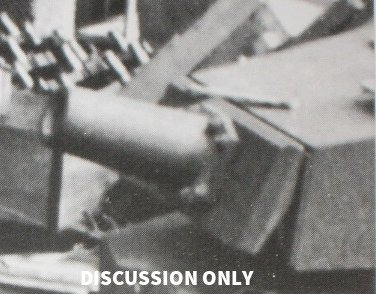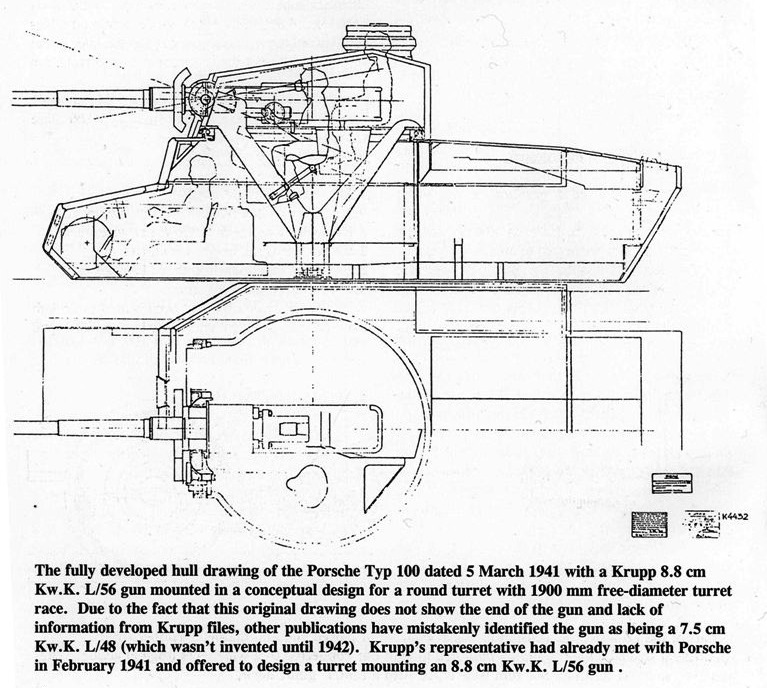Fortress gun
In 1887 the Belgian War Ministry ordered 185 5.7 cm fortress guns to arm their fortresses including Namur and Liege. The 5.7 cm Maxim-Nordenfelt was a short 26 caliber gun and not the longer 42-50 caliber QF 6-pounder Nordenfelt naval gun. It was a typical built-up gun of the period made of steel with a vertical sliding-block breech and it fired fixed QF ammunition of a number of different styles. The guns were mounted in Grusonwerke gun turrets or in armored casemates on central pivot mounts and used in an anti-personnel role.[1]
Infantry gun
In addition to its fortress gun role, it was deployed in an infantry gun role. The guns were mounted on light two-wheeled box trail carriages without a recoil mechanism and protected by a three-sided gun shield. During 1914 the Germans captured large numbers of these guns and used them in the infantry gun role mainly to engage enemy machine gun nests in support of infantry assaults. In 1916 the Germans had 450 of these infantry guns in service.[1]
Also, I found the original manual the names Gr. (P.) Gr.m.P. (P.).

It’s not a P. in parentheses, it’s a ? and the . after the P is actually the dot on the question mark. This makes sense because it’s a British document from 1918 and, judging by the abbreviation table in this document, Gr. would just be Gross which just means “Large” and Gr.m.P. would be Gross mit Phosphor which means “Large with Phosphorus,” neither of which make sense. So now I am trying to find the actual designation, but I don’t know where to start.
I know of that, its Notes on German Shells 1918 Second edition. (Or first)
And your assumtions is completly wrong.
Gr. Is Granate (Grenade) and m.P. is mit Panzerkopf (with AP head.)
This is not my assumption, this is this own document’s abbreviation table.



The document lists Granate as G., not Gr., and P. is listed as Phosphor. Even if this was P. (P.), that would be Pulver.
Granate mit Panzerkopf would make sense, but this document lists the abbreviations as Gross and Phosphor.
Probably some translation error.
m. P. = mit Panzerkopf
If Gr. meant large it should be in lower case letters
→ gr. for gross
Oh wait true you do make a good point.
That also lists m.P. as mit Panzerkopf, your 3rd picture
11th line.
I have added the 15 cm Mi.Gr.44 SAPHEDS-FS 70 kg 344m/s however unknown filler mass and type (tho most likely Amatol, because good, save, cheap and castable, like in the 15 cm I.Gr.)
If anyone knows the Filler mass that would be nice.
Source: H.Dv.119-256 and RH 8/252
Big news, with the upcoming 2 part vehicles such as this
EldE 98: Missile Trolley we can suggest a pulling vehicle and a gun on a standart lafett, if it can be used in the pulling configuration. Such would be an example Sd.Kfz.7 with 8,8 cm Flak or so.
So feel free to post here pictures of big aa and other guns in turrerts that are on a trailer or with trailer and pulled, that can be interesting and suggested after the update is live.
Like this.

I see the label on the bottom right, was this meant for the Porsche Tiger?
To my knowlege the Vk 30.01 (p)
“Work on the Typ 100 renewed in February of 1941, but the tank changed radically. The new gun required a new turret, one with an impressive turret ring diameter for the time: 1900 mm. There were even more ambitious plans of installing a 105 mm L/52 gun, like on the Pz.Sfl.IVa. Taking the drafts made by Krupp, Porsche K.G. prepared a reworked variant of the Typ 100 by March 5th. The hull of the tank became much shorter (6.3 meters), but widened around the turret ring to fit the necessary diameter.”
I remember that one from WoT. Was great until they massively nerfed it for no reason.
Wonder what it would look like with the bigger turret ring and new gun.
Technically, the bigger turret ring of 1900mm is the first designed turret ring. Only inbetween they made it to 1800mm
“Blueprint K4432 dated March 5th, 1941, which shows an 8.8 cm KwK 36 L/56 in the turret of the Typ 100. This is the first version of the turret with a 1900 mm turret ring. A different design was built in metal.”

Also, for a combination of stuff i already put together about pictures and drawings for my upcoming suggestions (105 and 88) for it. Look here:
Tiger 1: Heavy Tank, 1942-45
My suggestion was denied, as while the 88 suggestion works, the only difference between it and the 105 is the gun and to suggest the 105 variant, i need to proof that the 105 was actually build.
Maybe you come acoss something? Ill try searching, but tbh i dont even know where to start.
Technically here is the suggestion, its just not acceptable, until its proven that the gun was build in some form.
To save space.
I would like to sugges the Vk 30.01 (P) tank armed with the proposed 10,5 cm KwK L/47, which is a modified 10,5 cm K.18 L/52 with new one piece ammo and a little bit more power, but shorter barrel. While the gun lost to the 8,8 cm KwK 36 L/56 and the tank didnt go into produktion, this variant (along with the 8,8 cm variant exchanging power with reload speed) would be an interesting vehicle in line with the Vk 30.02 (M) already in game. It would be a smaller weaker variant to the Tiger I (or rather Vk 45.01(P), which it in the end evolved into.
Little History: (Click to show)
The VK 30.01(P) (or in general the full Vk 30.01 series by all companys) where the start of development of a heavy tank in the 25-30 ton class, after the B.W. (Pz IV) and Z.W. (Pz III) established themself as Medium tanks (at that time still in the 15-20 ton class).
The heavy tanks were envisioned and started after the Durchbruchwagen (breakthroughtank) project came to an end. Overall in the 25-30 ton class, with 50mm armor all around and either a 7,5 cm KwK L/24 or 10,5 cm KwK L/28 gun option, to be used also as Artilleriewagen (which later evolved into the VK 36.01(H) for heavyer fire support and bunker busting.
The task to start development of the tank started in 05.12.1939, under the name Typ 100 by Porsche, the Vk 30.01(P) bekame the first of in the developmental line. As usual, the chassis was to be developed by the company (in this case Porsche, along with Henschel with their own hull and the turrets by Krupp along with the armarment.
The German army already befor the war wanted a heavy tank as soon as 1938 with the Vk 30.01 as a siege tank. In the following years till 1941 and early 1942 devlopment was still running, as the war progresses, ever growing enemy tanks appeared and as such the requirements also grew, while the weight class set complications on how the design may look, starting at the Vk 30.01, growing into the
Vk 36.01 and eventually into the Vk 45.01 and then into the Tiger I.
The starting point for Porsches Typ 100 was a tank in the 30 ton clas by Franz Xaver Reimspiess, formerly emplyed at Austro-Daimler and worked on armored cars together with Porsche.
While over time as development progressed, the hull was keep mostly unchanged, only increasing in armor thickness as the requirments grew. It started with a 1800mm turret ring and an 8,8 cm KwK 36 L/56. While they were initially not content with the desing, not long after in 05.1941 a new design was already finished, still with 1800mm turret ring. This turret already looked very similar to the Tiger I turret, with the new full cast commanders drum. However the turret roof was on one continues angle. Still with the 8,8 cm gun.
As work continued, the armarment was again put to choice, 8,8 cm KwK 36 L/56, 8,8 cm KwK L/57 with increased power and chamber or the 10,5 cm KwK L/47. This required to go to a 1900mm turret ring. The new turret was again asymetral and went back to the older style commanders cupola.
In the end for production efficiency as well as beeing simply enough, the 8,8 cm KwK 36 L/56 was chosen, while the 10,5 cm gun was very powerfull, offering very good performance against tanks, bunkers and infantry with practically the same shells as the LeFH 18, starting production on it was uneconomic.
The overall armor for the turret was 80mm to the front, 60mm on the sides, while the hull was 80 or 100mm at the front and the rest also 60mm. The weight most likely surpassed 30 and even 45 tons.
Overall 2 complete hulls in full condition were build as well as mockups of the turrets. The Ararments were build and tested.
The 10,5 cm KwK L/47 was a adaption of the 10 cm schwere Kanone 18 L/52 with new one piece ammo of 1100mm complete length and shorter barrel. Compared to the original gun it has a slight performance boost.
The Armarment: 10,5 cm KwK L/47 and Coax Mg 34
10,5 cm KwK L/47
For the Vk 30.01 (P) tank armed with the proposed 10,5 cm KwK L/47, which is a modified 10,5 cm K.18 L/52 with new one piece ammo and a little bit more power, but shorter barrel. While the gun lost to the 8,8 cm KwK 36 L/56 and the tank didnt go into produktion.
Caliber: 105mm
Ammo: 105x672mm
Fire Rate: 12 rpm
Single Shot, Horizontal sliding Breechblock
Muzzle velocity: 837, 850m/s
Weight: 1960 kg
Mounting: Main Tank gun
Ammo Types: Apcbc, He, Saphe
Ap:
Pzgr. Rot (Apcbc) 15,56 kg 250g (357,5g) 837m/s 192mm/10m


Pzgr. Rot (Ei) ((S)apbc) 15,56kg 135g Fp.02, Fp.10 and Pyrin (173g Tnta?) 837m/s 182mm/10m

He:
Gr.19 (He-TF (No Tracer)) 15,14kg 1,75kg Fp.02 and Np.10 850m/s


Gr.19 (Bo.Pr) (He-TF (No Tracer)) 15,14kg 1,85kg Fp.02 and Np.10 850m/s


Chassic characteristics: (Click to show)
Armor:
Frontal 80mm sides and back 60mm for turret and hull.
Weight: 30 ton (or more)
Length 6.58 m
Width 3.05 m
Height 2.8 m
Engine: 2x V10 210 Ps for 420Ps
Speed: 60 km/h both directions.
Crew: 5
Source:
Bundesarchiv
Geschossringbuch II
Tankarchives
Ferdinand und Elefant Tank Destroyer
Wunderwaffen neuartige Waffensysteme des Deutschen Heeres
Hitleers Tanks German Panzers of WW2
Nah, I pretty much never look for german stuff on my own, no idea how I’d even find something like that. I’ve been struggling myself to find good source material on japanese aviation.
























































